Cite this document
(Key Differences in Media and Academia Book Report/Review, n.d.)
Key Differences in Media and Academia Book Report/Review. https://studentshare.org/media/1831126-science-reported-in-media-vs-scholarly-sources
Key Differences in Media and Academia Book Report/Review. https://studentshare.org/media/1831126-science-reported-in-media-vs-scholarly-sources
(Key Differences in Media and Academia Book Report/Review)
Key Differences in Media and Academia Book Report/Review. https://studentshare.org/media/1831126-science-reported-in-media-vs-scholarly-sources.
Key Differences in Media and Academia Book Report/Review. https://studentshare.org/media/1831126-science-reported-in-media-vs-scholarly-sources.
“Key Differences in Media and Academia Book Report/Review”. https://studentshare.org/media/1831126-science-reported-in-media-vs-scholarly-sources.


